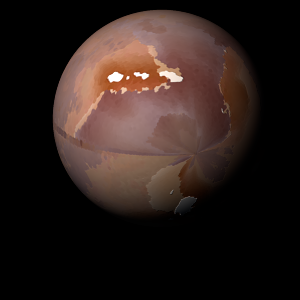|
|
Space Astro
|
Info for exoplanet "Minabya Ge"
| Scientific (actual) data |
|---|
| Name | Kepler-1998 b |
| Planet status | Confirmed |
| Radius | 0.061933 |
| Orbital period | 3.03264 |
| Semi major axis | 0.0405 |
| Orbit eccentricity | 0 |
| Inclination | 88.93 |
| Discovered | 2017 |
| Updated | 2024-06-28 |
| Tzero tr | 2454970 |
| Impact parameter | 0.238 |
| Temperature (kelvin) | 1187 |
| Publication | Announced on a website |
| Detection type | Primary Transit |
| Radius measurement type | Primary Transit |
| Alternate names | KOI-2583.01, KOI-2583 b |
| Star name | Kepler-1998 |
| Right ascension | 283.43° |
| Declination | 47.59° |
| Mag v | 12.74 |
| Mag i | 12.423 |
| Mag j | 11.462 |
| Mag h | 11.142 |
| Mag k | 11.076 |
| Star distance | 340.965 |
| Star metallicity | 0.096 |
| Star mass | 0.985 |
| Star radius | 0.9914 |
| Star sp type | G5V |
| Star age | 4.7 |
| Star temperature | 5581.44 |
| Star alternate names | KIC 10387742, KOI-2583, 2MASS J18534298+4735330, TIC 164525250 |
| Wikipedia article | Kepler-1998 b |
Back
| |
| Fictional info (?) |
|---|
| Suggested name | Minabya Ge |
| Planet type | Hot planet |
| It is the coldest planetary atmosphere in its solar system, with a minimum temperature of 38°K (-235°C), and has a complex, layered cloud structure with oxygen thought to make up the lowest clouds, and nitrogen the uppermost layer of clouds. The planet telescopically displays the complete range of phases, similar to Venus and the Moon, as it moves in its inner orbit relative to Kepler-1998, which reoccurs over the so-called synodic period approximately every 70 days. |
| Atmosphere | Nitrogen | 59% |
| Oxygen | 29% |
| Hydrogen deuteride (HD) | 9.2% |
| Hydrogen peroxide | 1.7% |
| Carbonyl sulfide | 0.26% |
| Atmospheric pressure | 70 bar |
 |
| Moon | Kuzeta Raya | Large round ice asteroid |
| Sotepu Minu | Very small round rocky moon |
| Gyocho | Small round crater-filled moon |
| Google search for Minabya ge |
|
Website by Joachim Michaelis
|
|
|
|